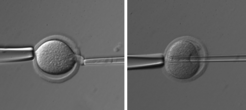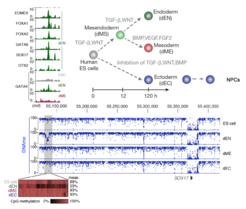Pluripotency and reprogramming
Mechanisms of somatic cell reprogramming

We always had an interest in the molecular mechanisms of somatic cell reprogramming. Initially focused on nuclear transplantations and later using transcription factor induced reprogramming. For the latter, virtually nothing was immediately transparent in this new field: when confronted with a cocktail of inducing factors, somatic cells exhibited a wide range of behaviors and, after weeks, pluripotent cells would emerge seemingly at random. While many initially accepted this randomness as an inherent attribute, we alternatively utilized a clonally inducible model through which different components of this process could be dissected with experimental rigor. Over the past decade we described the transcriptional and epigenetic impact of reprogramming on somatic cells to assign specific molecular landmarks, providing substantial clarity to the underlying mechanisms and interpretation of this process, as well as an improved methodology for its study. We have been at the forefront of several key transitions in the field, including the molecular equivalence of induced pluripotency to ES cells, the fundamental contributions of epigenetic regulators, and the interplay of stochastic and deterministic transitions.
Further reading:
Mikkelsen et al. Nature 2008
Smith et al. Nature Biotechnology 2010
Koche et al. Cell Stem Cell 2011
Bock et al. Cell 2011
Chan et al. Nature Genetics 2013
Smith et al. Nature Reviews Molecular Cell Biology 2016
Executing pluripotent potential (differentiation)
Another major area in the lab has focused on dissecting the epigenetic mechanisms underlying pluripotency and differentiation. Human pluripotent stem cells possess the ability to self renew in vitro while maintaining a developmental plasticity that is similar to that exhibited by progenitor cells of the very early embryo. We continue to dissect how various transcription factors are able to access silent heterochromatin and gain insights on the individual steps during the transition to both primed and active states. We have made significant progress in differentiating human ES cells into all three germ layers and have extensively studied these early progenitor stages. We are now complementing these with several consecutive stages within selected lineages. Using epigenetic dynamics and footprints combined with computational modeling we began to derive regulatory hierarchies that control these cell state transitions. We have and continue to perform genetic manipulations to provide functional support for the various (presumably) regulatory events.

Further reading:
Bock et al. Cell 2011
Gifford et al. Cell 2013
Ziller et al. Nature 2013
Tsankov et al. Nature 2015
Ziller at al. Nature 2015
Roadmap Epigenomics Consortium Nature 2015
Liao et al. Nature Genetics 2015
Tsankov et al. Nature Biotechnology 2015

